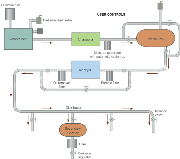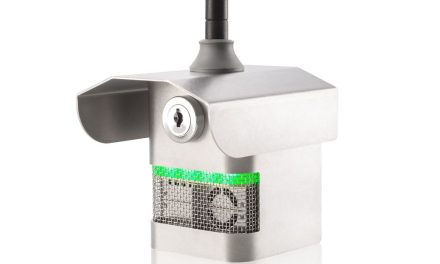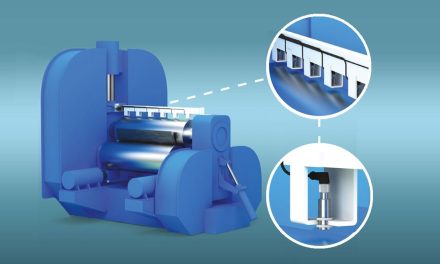 There are a number of considerations to take into account when selecting a heavy-duty pressure transducer for pneumatic applications, says Ketan Mehta, senior global product marketing manager at Honeywell Sensing and Control
There are a number of considerations to take into account when selecting a heavy-duty pressure transducer for pneumatic applications, says Ketan Mehta, senior global product marketing manager at Honeywell Sensing and Control
Heavy-duty pressure transducers are used to measure and control high-pressure compressed air and gases in pneumatic applications. At the heart of any pneumatic application is the air compressor, which provides pressurised air to ‘power’ the pneumatic machine or tool. Here, the transducer converts the pressurised air or pressure per square inch (PSI) measurement into a digital or
analogue electrical signal so it can allow for precise control in a variety of manufacturing, construction, chemical production, power tool, oil and gas, food and beverage and medical equipment applications. The typical pressure range for heavy-duty applications is 100 to 1000 psi.
Such pressure transducers may be used in industrial air compressor applications to measure and control inlet and outlet pressure, filter pressure drop, cooling water inlet and outlet pressure, and compressor oil pressure. The transducer plays a primary role in maintaining compressor performance and efficiency.
One example is Honeywell’s PX2 pressure transducer, which can be used to measure the air pressure in a receiver tank (See Figure 1). The air pressure in the tank regulates the compressor operation to start or stop. This compressor example can be used in all types of industrial applications, including using the compressed air in PET bottle manufacturing moulding the plastic bottles themselves, and operating power tools such as air hammers, pneumatic nail drivers and jackhammers.
A transducer typically provides two pressure measurements:
• It identifies the suitable amount of pressurised air being delivered to the application;
• It monitors for air pressure leakage, which allows for the maintenance of the line pressure.
Selecting the best transducer for an application centres on how reliable and how accurate the air pressure measurement is, so optimum compressor performance can be maintained.
Selection criteria
When selecting a heavy-duty pressure transducer, a number of key performance specifications need to be considered, including total accuracy measured as the total error band (TEB), configurability and durability. Other important considerations include calibration, offset compensation and wide pressure ranges. Together, these factors can affect product performance, total cost of ownership, and time to market.
The selection criteria for transducers should be based on the overall need for consistency and reliability of the system.
So, here are four things that designers should consider when selecting a transducer for a pneumatic air compressor application.
Accuracy and consistency: TEB is one of the most important specifications to consider when selecting a transducer. TEB consists of all possible sources of transducer error, and indicates the device’s true accuracy over the compensated temperature range, for instance -40°C to +125°C. As an example, a TEB of ±2% indicates that the error will be within 2% of the established value over the operating temperature range, whether the pressure increases or decreases. Understanding TEB is crucial to ensure the transducer will operate accurately within the pressure range and operating temperature to deliver consistent, reliable and repeatable air pressure readings.
Benefit: Transducer-to-transducer interchangeability due to minimal part-to-part variation in accuracy; eliminates the need for transducer testing and calibration; and helps ensure system accuracy, all of which are critical in the quality control of the final product.
It’s important to note that some transducer manufacturers do not provide TEB in their datasheets. In many cases, they only provide accuracy errors (pressure non-linearity, pressure hysteresis, and pressure non-repeatability), which is only one component of the TEB (See Figure 2). This makes it very difficult to compare and evaluate different transducers.
Configurability: Look for a product platform approach that provides designers with several choices for key transducer specifications – connectors and cabling, ports, pressure types, pressure ranges and outputs. This eliminates the need for a custom design – which includes sourcing from different vendors and qualifying and testing the parts for reliability – while providing designers with the ability to configure the transducer to meet their requirements in an off-the-shelf solution. This means designers can virtually design a custom product by selecting from standard options within the product platform.
Benefit: Helps lower device cost; reduces overall design, integration, and implementation costs; and speeds up device sampling for a faster time to market. In addition, since vendors are reusing proven technology, design and processes, it also reduces potential design and purchasing risks.
Durability: Transducers should be compatible with a variety of harsh media, offer a wide operating temperature range of -40°C to +125°C, and feature a sealing rating of up to IP69. They should also provide EMC protection and meet CE compliance. In addition, transducers based on piezoresistive sensing technology with ASIC signal conditioning allow for compatibility with a variety of harsh media. It is also important to consider all materials in the transducers that will come in contact with the media. Transducers with stainless steel housings , for example, add further protection from a wide range of harsh media.
Benefit: Allows the device to be used in harsh environments.
Supplier quality and support: Designers should also take into account a vendor’s quality processes, global footprint and design support. Vendors should use Six-Sigma quality standards in their manufacturing processes to produce high quality and high performance transducers. Another consideration is vendor application support throughout the design and production process. Does the vendor have the breadth of product, design support and global presence to support design and production requirements?
Benefit: Provides the designer with the assurance that the transducer will operate to the specifications over the expected product life cycle, and that the vendor is readily available to provide design, application and manufacturing support.
Design considerations
Other considerations on the design checklist for heavy-duty pressure transducer selection include:
• Transducers should be fully compensated, calibrated and amplified to provide a ‘plug-and-play’ solution.
• Custom calibration should be available with a variety of regulated output voltages to eliminate the need for costly design modifications.
• A broad compensated temperature range allows the transducer to be used throughout the system design, while providing a true pressure measurement reading.
• A wide pressure range of 100 to 1000 psi also allows the transducer to be used in various points across the system.
• Availability of several connector and port options allows the transducer to meet a design’s specific requirements globally.
• Packaging and small footprint for greater flexibility in device placement.
• Industry standard compliance such as ISO 9001.
As an example, Honeywell’s PX2 Series of pressure transducers is a highly configurable line that offers a wide selection of options for connectors and cabling, ports, pressure types, pressure ranges and outputs. The PX2 Series currently offers 5,000+ possible combinations, with more to come over the next year.
Based on piezoresistive-sensing technology with ASIC signal conditioning, they meet the criteria for use in harsh environments. They feature a TEB of ±2% over the operating temperature range of -40°C to 125°C, and are fully calibrated and compensated for transducer offset, sensitivity, temperature effects and non-linearity.
Meeting requirements
A design checklist can help designers select a transducer that meets their design requirements for pneumatic air compressor applications without the additional time and cost of custom modifications. This will ensure the selection of a cost-effective solution that takes into consideration the total cost of the transducer, which includes ease of integration and implementation.
Honeywell


